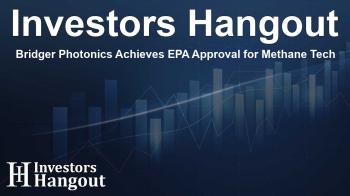Bridger Photonics Achieves EPA Approval for Methane Tech

Bridger Photonics Receives Crucial EPA Endorsement
Bridger Photonics, a prominent player in the methane detection sector, has recently announced that its Gas Mapping LiDAR™ technology has gained approval from the Environmental Protection Agency (EPA) for regulatory compliance. This breakthrough is set to revolutionize how oil and gas operators address fugitive methane emissions, offering them a powerful tool for emissions detection and compliance.
Impact on the Oil and Gas Industry
The approval from the EPA opens new doors for operators aiming to diminish methane emissions. This technology provides them with the ability to effectively conduct emissions scans and facilitate repairs, ultimately aligning with both environmental standards and business objectives.
Adoption by Industry Leaders
The significance of this approval is underscored by the voluntary adoption of Bridger’s technology by numerous industry leaders, including nine of the leading ten natural gas producers in the U.S. The EPA’s inclusion of advanced technology in its latest comprehensive "Methane Rule" reflects feedback from various industry stakeholders, highlighting the need for more efficient methods in emissions detection.
Benefits of Aerial Monitoring
Previously established traditional methods of emissions detection can be both time-consuming and less effective. Bridger’s innovation provides a technological advantage, allowing operators to streamline their operations and make informed decisions about repairs and emissions reductions. This technology enables aerial scanning of facilities at rates exceeding ten times faster than conventional ground crews, allowing for effective prioritization of efforts.
Response from Leadership
Bridger’s co-founder and CEO, Pete Roos, expressed enthusiasm regarding the regulatory approval, stating, "Our team has worked tirelessly to develop and optimize our proprietary technology. The widespread voluntary adoption of our technology by the oil and gas industry has established the value we provide outside of the regulatory framework." Roos emphasized that this approval will simplify compliance and enhance emission reductions within the industry.
Understanding the Technology
The Gas Mapping LiDAR™ technology utilizes sophisticated laser sensors mounted on small aircraft and helicopters. This innovative approach allows for extensive coverage of oil and gas infrastructure, permitting a comprehensive survey of emissions. The technology identifies, localizes, and quantifies emissions, providing actionable data that operators can use to efficiently address leaks and other systemic issues.
Effective Leak Detection
Bridger's aerial deployment capability facilitates rapid detection and identification of emissions, which significantly aids in prompt mitigation efforts. Roos remarked, "This allows ground crews to focus their attention where it matters most—on identifying and resolving emissions while avoiding unnecessary visits to locations without emissions." This strategy not only enhances efficiency but also contributes to significant cost savings.
Opportunities for Collaboration
For operators interested in harnessing the benefits of Bridger Photonics’ technology, further information can be accessed on their website, where resources and guidelines for engagement are provided.
About Bridger Photonics, Inc.
Bridger Photonics is at the forefront of aerial methane detection, localization, and quantification, playing a vital role in the natural gas value chain. Their mission is centered around promoting safe, clean, and efficient oil and gas operations through data-driven insights aimed at reducing methane emissions.
Frequently Asked Questions
What is Gas Mapping LiDAR™ technology?
This is an innovative technology developed by Bridger Photonics that uses laser sensors on aircraft to detect and quantify methane emissions over oil and gas infrastructure.
How does this approval benefit the oil and gas industry?
The EPA approval allows operators to utilize advanced detection technology for regulatory compliance and emissions reduction, improving efficiency and operational effectiveness.
What are the advantages of aerial monitoring compared to traditional methods?
Aerial monitoring significantly speeds up detection processes, allowing for efficient prioritization of repair efforts based on emissions data, which traditional methods lack.
Who are the primary users of this technology?
Operators within the oil and gas industry, particularly major players in natural gas production, are the primary users benefiting from this technology.
How can operators engage with Bridger Photonics?
Operators interested in this technology can visit Bridger Photonics' website to explore more about their offerings and how they can collaborate.
About The Author
Contact Owen Jenkins privately here. Or send an email with ATTN: Owen Jenkins as the subject to contact@investorshangout.com.
About Investors Hangout
Investors Hangout is a leading online stock forum for financial discussion and learning, offering a wide range of free tools and resources. It draws in traders of all levels, who exchange market knowledge, investigate trading tactics, and keep an eye on industry developments in real time. Featuring financial articles, stock message boards, quotes, charts, company profiles, and live news updates. Through cooperative learning and a wealth of informational resources, it helps users from novices creating their first portfolios to experts honing their techniques. Join Investors Hangout today: https://investorshangout.com/
The content of this article is based on factual, publicly available information and does not represent legal, financial, or investment advice. Investors Hangout does not offer financial advice, and the author is not a licensed financial advisor. Consult a qualified advisor before making any financial or investment decisions based on this article. This article should not be considered advice to purchase, sell, or hold any securities or other investments. If any of the material provided here is inaccurate, please contact us for corrections.

